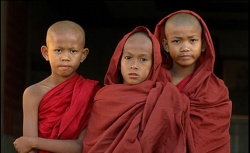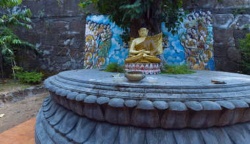The Three Jewels by Arnie Kozak, Ph.D
Buddha means the Awakened One, the Enlightened One. For the buddha jewel you take buddha as your refuge. But it's not the person of the Buddha that is sought for refuge; rather, it is the possibility for awakening. The Buddha taught that everyone has buddha-nature, that is, the capacity to awaken. You are buddha, and it is to this realization that refuge is taken.
Dharma has multiple meanings. Dharma is the collection of the Buddha's teachings. In the Buddha's time wandering ascetics would meet each other and ask, “Whose dharma do you follow?” They would then provide the name of their teacher. The Buddha was unique in that he did not follow another teacher's dharma but had figured things out for himself under the pipal tree. Dharma also refers to the deeper truths that the Buddha's teachings point to.
It refers to the truth of dukkha and the possibility of nirvana. Dharma is also translated as “natural law”: seeing clearly into the reality of things.
Equally important is the community, the sangha. The early sangha was comprised of the Buddha and his followers. This included his former five ascetic friends and the proliferation of people that followed, including common people and kings. People joined the community through their wish to end suffering and upon hearing the wisdom of the Buddha. You could become monastic or be part of the community as a lay practitioner. 2,500 years later, these choices are still available, and the sangha is one of humanity's oldest continuous institutions.
Yet, it is not a formal community. It has no central authority, holds no annual conference, and has no membership roster. It is a loosely collected group of like-minded individuals who practice living the Four Noble Truths and other Buddhist teachings, practices, and rituals that have developed over the centuries. The sangha is the worldwide collection of Buddhist practitioners as well as the small group of people with whom you meet to meditate together on a regular basis in your community. Even individuals who practice on their own are part of the sangha.Taking refuge in the Buddha does not mean that you are hidden and protected by a great and powerful force. It means to align yourself with the Buddha and strive to become a buddha yourself. Similarly, you can take refuge with the dharma by aligning yourself with the teachings. Likewise, you can take refuge in the sangha.
The sangha is not just about membership or social support. It's more than being a card-carrying Buddhist. The sangha provides support for your practice. Each member of the sangha supports each other. To sit in meditation with a group provides a different experience. It gets you to sit up straighter and put more effort into your practice. And it also provides something intangible, something ineffable and powerful. The sangha is the glue that keeps everything together.

